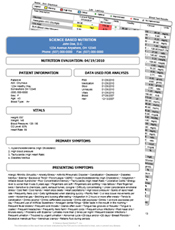“Detoxification” is a naturally occurring process that the body is designed to perform to rid the body of waste products that occur as part of normal metabolism. In addition, it works to rid the body of toxic elements that are inhaled or consumed from the foods we eat and the environment around us. Detox diets have become very popular for many different maladies from cancer to weight loss. There are many different programs, but most of them involve very low caloric intake, with addition of fruits and vegetables, water and supplements. In theory, once “free” of toxins, your body functions better and your metabolism performs more efficiently which may help shed those extra pounds or fight off disease.
The problem herein lies in that many of these diets are not balanced diets and some supplements can force the body to detox too much and too fast. Experts agree that there is no credible science to validate claims that detox diets work. There are no studies available to document the benefits; instead, most claims are based on testimonials. Most of the positive testimonials can be easily explained. Many who use these detox diets are simply cutting out the plethora of processed foods, fast foods and sugar laden foods that burden the body. It doesn’t take a PhD to know they are going to “feel” better when they get off of these poor quality foods. However, some of these diets are pretty extreme and potentially dangerous.
Long term fasting will leave you in a severe energy and protein deficient state. The body will then be forced to turn to stored body fat and muscle protein for fuel which can lead to excessive muscle breakdown and nutrient deficiencies. This will ultimately have a negative impact on metabolic rate which is the rate at which the body heals and repairs and determines how fast chemical reactions occur including calories burned.
So what causes the buildup of toxins? Toxins can come from the food we ingest, the water we drink, the air we breathe, the chemicals used in everyday jobs and chores and even the home we live in. This list can go on and on. It is important to remember that it is impossible to remove every harmful chemical from the body and there is no perfectly “clean” place on Earth to live. Yet, this human body we’ve each been given is designed to handle a certain amount of toxicity…the health problems start to occur in the case of toxic overload, poor nutritional status and the individual’s ability or inability to excrete the toxic elements. There are some tests you can do to help you become more aware of toxic elements in your environment and evaluate your ability to excrete them efficiently. This can be an important factor for your long term health. We will elaborate on those tests next month in Part 2 of “Detoxing: Is it for you?”
Your body is continuously “detoxing” or cleaning itself as part of the normal metabolic functions of the liver, kidneys, colon, skin, blood and lymphatic system. These harmful chemicals are filtered and flushed out in the urine or feces. However, if you are deficient in essential minerals such as calcium and magnesium the body will store toxic metals in their place (3).
- Calcium is replaced by lead, which deposits primarily in bone, and disrupts the formation of red blood cells. Lead toxicity can contribute to anemia and lead to osteopenia and osteoporosis.
- Zinc is replaced by cadmium, which tends to accumulate heavily in your kidneys. Cadmium overload is associated with peripheral neuropathy.
- Magnesium is replaced by aluminum, which, among other things, induces neurochemical changes and has been identified as a contributing factor to developing Alzheimer’s.
- Manganese is replaced by nickel, which is carcinogenic.
Not only do our bodies have to deal with heavy metals such as lead, arsenic and mercury but there is increased burden because of exposure to pesticides. Over 98% of sprayed insecticides and 95% of herbicides reach a destination other than their target species, including non-target species (humans), air, water and soil.(1) The United States Environmental Protection Service states, “Pesticide exposure can cause a variety of adverse health effects. These effects can range from simple irritation of the skin and eyes to more severe effects such as affecting the nervous system, mimicking hormones causing reproductive problems, and also causing cancer” (2). According to the Stockholm Convention on Persistent Organic Pollutants, 9 of the 12 most dangerous and persistent organic chemicals are pesticides (3). Many of the breakdown products of pesticides are even more toxic than the parent compounds. To make matters worse, according to West Kootenay Airshed Protection organization, “The pesticide labeling law unfortunately does not require manufacturers to list inert ingredients, and ‘trade secrets’ allow them to avoid disclosure to customers, so you cannot tell by reading a product label whether a pesticide contains an endocrine-disrupting ingredient” (4).
Your indoor air may be more harmful than the outdoor air. Pesticides that break down within days outdoors may last for years in carpets, where they are protected from degradation caused by sunlight and bacteria5. Most alarming, the common pesticides used on lawns and farms are shown in medical research to accelerate damage of the immune and nervous system, leading to serious health problems years after exposure.
You cannot be optimally healthy unless you address toxic elements in your environment. There are certain tests you can do to determine toxic elements in you environment, your ability to excrete such toxic elements and monitor their effects on your health. Look for Part 2 of “Detoxing” coming next month where we’ll elaborate on this topic. Can’t wait? Getting a comprehensive blood analysis and appropriate toxic element testing will not only define your state of health but will allow an expert to advise you on specific amounts of vitamins and minerals you need to be healthier and if “detoxing” should be a concern for you. Call us today to schedule your appointment.
References:
- Miller GT (2004), Sustaining the Earth,6th edition. Thompson Learning, Inc. Pacific Grove, California. Chapter 9, Pages 211-216.via Wikipedia.
- United States EnvironmentalProtection Service http://www.epa.gov/pesticides/health/human.htm
- Secretariat of the StockholmConvention Ridding The World of Persistent Organic Pollutants. United Nations Environment Programme.April 2005
- West Kootenay Airshed Protection. Cosmetic Use of Pesticides. http://www.ncap.kics.bc.ca/8pesticides.html Accessed on April 24, 2012


